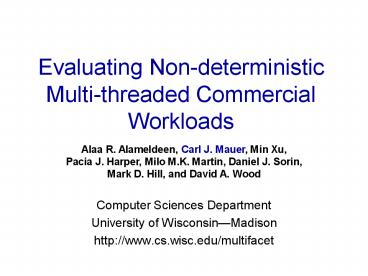Evaluating Non-deterministic Multi-threaded Commercial Workloads - PowerPoint PPT Presentation
Title:
Evaluating Non-deterministic Multi-threaded Commercial Workloads
Description:
Uncontrolled factors. Want to separate random from systematic effects ... No uncontrolled factors. Wrong! Multi-threaded workloads can be unstable ... – PowerPoint PPT presentation
Number of Views:47
Avg rating:3.0/5.0
Title: Evaluating Non-deterministic Multi-threaded Commercial Workloads
1
Evaluating Non-deterministic Multi-threaded
Commercial Workloads
Alaa R. Alameldeen, Carl J. Mauer, Min Xu, Pacia
J. Harper, Milo M.K. Martin, Daniel J.
Sorin, Mark D. Hill, and David A. Wood
- Computer Sciences Department
- University of WisconsinMadison
- http//www.cs.wisc.edu/multifacet
2
Introduction
- Short measurements on real machines require
multiple runs - Uncontrolled factors
- Want to separate random from systematic effects
- Simulation measurements use a single run
- Simulators are deterministic
- No uncontrolled factors
- Wrong!
- Multi-threaded workloads can be unstable
- Small changes in timing cause large changes in
results
3
Introduction
- Instability may affect conclusions
- Comparing Direct Mapped to Set-Associative Caches
4
Overview
- Introduction
- Methods
- Workloads
- Result I Process scheduling
- Result II Workload Variability
- Conclusion
- Future Work
5
Methods
- Real machine
- Setup, tune, validate on a 16-processor Sun E6000
- 8 16 X speed-up for each application
- Simulator
- Simics, Full-system simulator running Solaris 8
- Ruby, Memory timing simulator
- Experiments
- Start from a warm checkpoint
- Measure throughput (transactions completed / time)
6
Workloads
- OLTP
- TPC-C-like benchmark using a 1 GB database
- SPECjbb
- Server-side Java-based middleware workload
- Apache
- Static web serving Apache driven by SURGE
- Slashcode
- Dynamic web serving message board, using code and
data similar to slashdot.org
7
Why unstable?
- Different paths are executed
- Hypotheses
- Process scheduling
- Order of lock acquisition
8
Result I Process scheduling
- Deterministic simulation of OLTP on uniprocessor
- Artificially injected misses to I-cache
- Run1 0, 100, 200
- Run2 50, 150, 250
- Measured equivalent to 3-5 seconds in real system
- Run time difference of 9
- Is process scheduling a factor?
9
Result I Process scheduling
- Traced process groups scheduled on CPU
10
Methods, part II
- Pseudo-random perturbations
- Run multiple runs from same checkpoint
- All runs have same average memory latency
- Misses to main memory perturbed by 0-4
- Calculate mean, standard deviation
11
Result II Variability
- Variability
- 16-processor system running 8,000 OLTP
transactions - 20 runs from same checkpoint
- 12 20 seconds in real system
- 1 / Throughput (cycles per transaction)
12
Result II Variability
- Miss rate (misses per transaction)
13
Result II Variability
- Instructions executed (per transaction)
- Hypothesis
- Spin-waiting hypothesis
- Lock-acquisition, idle loop, device activity
14
Result II Variability
15
Conclusion
- Multi-threaded commercial workloads can be
unstable even on uniprocessors - Instability can affect conclusions in short runs
- Pseudo-random methodology can help
- Even within one workload variations exist
16
Future Work
- Root cause(s)?
- Methodology improvements
- Quantify instability further
17
Questions































